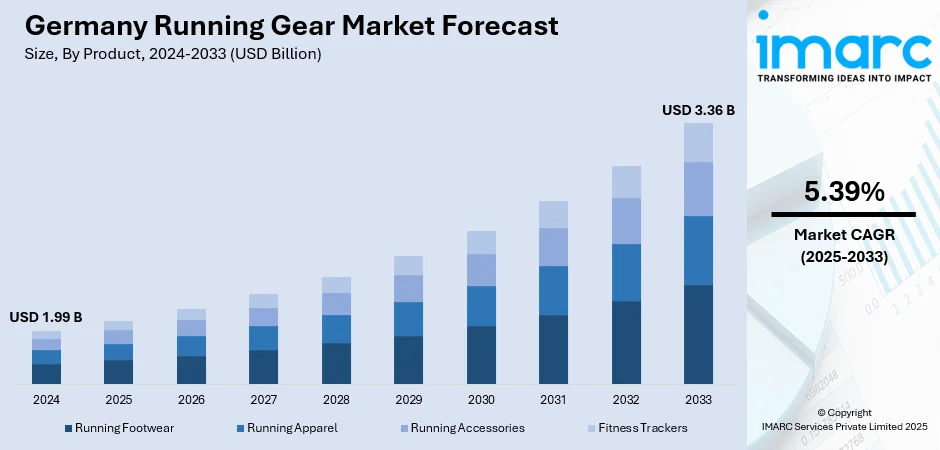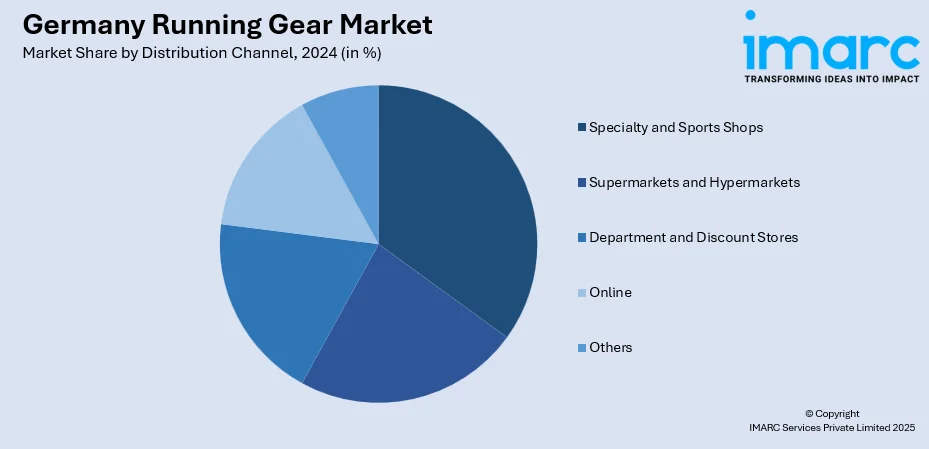
Germany Running Gear Market Size, Share, Trends and Forecast by Product, Gender, Distribution Channel, and Region, 2025-2033
Germany Running Gear Market Overview:
The Germany running gear market size reached USD 1.99 Billion in 2024. Looking forward, the market is projected to reach USD 3.36 Billion by 2033, exhibiting a growth rate (CAGR) of 5.39% during 2025-2033. The market is driven by expansion of omnichannel retail models combining online, live commerce, and physical delivery for convenience and personalization. Widespread participation in running events, community races and wellness-oriented lifestyles fuels demand for performance gear adapted to climate and biomechanics. Furthermore, continual innovations in footwear technology, materials, and sustainable design, backed by competitive brand strategies, are further augmenting the Germany running gear market share.
|
Report Attribute
|
Key Statistics
|
|---|---|
|
Base Year
|
2024
|
|
Forecast Years
|
2025-2033
|
|
Historical Years
|
2019-2024
|
| Market Size in 2024 | USD 1.99 Billion |
| Market Forecast in 2033 | USD 3.36 Billion |
| Market Growth Rate 2025-2033 | 5.39% |
Germany Running Gear Market Trends:
Cultural Embrace of Running and Health-Oriented Lifestyles
Germany hosts a vibrant running culture supported by numerous city marathons, trail events, and grassroots running communities. Participation in events such as the Berlin Marathon and local fun runs reinforces demand for performance gear tailored to endurance and recreational runners. A significant share of Germans engage in regular fitness activities, with health-conscious behaviors reflected in gear purchases geared toward biomechanical comfort, weather insulation, and versatility. In August 2024, German sportswear company PUMA launched the Fast RB NITRO Elite, a high-performance running shoe featuring 58mm of NITROFOAM Elite, 18mm above race regulations, designed to deliver superior cushioning and energy return. The shoe integrates three PWRPLATEs for enhanced propulsion, a laceless mesh upper with PWRTAPE, and PUMAGRIP for traction, aiming to challenge design norms and boost elite runner performance. Runners frequently replace footwear and apparel due to wear and evolving technology. Sustainability considerations are increasingly influential, prompting selection of recycled fabrics and ethically sourced materials. Fitness apps and virtual race participation further bolster motivation and gear turnover. This cultural shift toward active lifestyles fosters consistent engagement with brands offering performance-enhancing, climate‑appropriate, and eco‑friendly running products, significantly contributing to Germany running gear market growth.

To get more information on this market, Request Sample
Technical Innovations and Competitive Brand Ecosystem
Germany’s running gear market is characterized by strong competition focused on innovation in materials, fit, and sustainability. Brands such as On, Brooks, Adidas, Nike, Salomon, and New Balance emphasize product advancements in cushioning, lightweight resilience, and temperature control tailored for European terrains and weather conditions. German engineering heritage supports integration of technologies like 3D‑printed midsoles and performance textiles with moisture-wicking and compressive properties. In November 2024, BASF and Hong Kong-based brand Mount to Coast introduced CircleCELL™, the first running shoe midsole made with BASF’s ecoflex® BMB biopolymer, which delivers the same energy return as traditional PEBA materials while being 90% more durable. The ecoflex® BMB grade uses a biomass balance approach with certified renewable feedstocks derived from organic waste, supporting greater sustainability in performance footwear manufacturing. Sustainability credentials such as recycled content, low-emission production and certifications like Grüner Knopf influence brand credibility and consumer choice. Several local brands combine premium performance with eco-driven narratives and active community sponsorships. Retailers offer gait analysis services and customizable options to align gear with individual biomechanics. These competitive dynamics and continuous product enhancements support strong market positioning, repeat purchases, and brand loyalty.
Germany Running Gear Market Segmentation:
IMARC Group provides an analysis of the key trends in each segment of the market, along with forecasts at the country and regional levels for 2025-2033. Our report has categorized the market based on product, gender, and distribution channel.
Product Insights:
- Running Footwear
- Running Apparel
- Running Accessories
- Fitness Trackers
The report has provided a detailed breakup and analysis of the market based on the product. This includes running footwear, running apparel, running accessories, and fitness trackers.
Gender Insights:
- Male
- Female
- Unisex
The report has provided a detailed breakup and analysis of the market based on gender. This includes male, female, and unisex.
Distribution Channel Insights:

- Specialty and Sports Shops
- Supermarkets and Hypermarkets
- Department and Discount Stores
- Online
- Others
The report has provided a detailed breakup and analysis of the market based on the distribution channel. This includes specialty and sports shops, supermarkets and hypermarkets, department and discount stores, online, and others.
Regional Insights:
- Western Germany
- Southern Germany
- Eastern Germany
- Northern Germany
The report has also provided a comprehensive analysis of all major regional markets. This includes Western Germany, Southern Germany, Eastern Germany, and Northern Germany.
Competitive Landscape:
The market research report has also provided a comprehensive analysis of the competitive landscape. Competitive analysis such as market structure, key player positioning, top winning strategies, competitive dashboard, and company evaluation quadrant has been covered in the report. Also, detailed profiles of all major companies have been provided.
Germany Running Gear Market News:
- In September 2024, Adidas launched the Adizero Adios Pro 4 and Evo SL, developed in Herzogenaurach, Germany, to boost race and training performance. The Pro 4 features a forefoot rocker at 60% length, Lightstrike Pro midsole, and will be available January 2025 for USD 250. The Evo SL is designed for fast training runs, weighs 224g (men’s) and 188g (women’s), incorporating a full-length Lightstrike Pro foam and engineered mesh upper.
Germany Running Gear Market Report Coverage:
| Report Features | Details |
|---|---|
| Base Year of the Analysis | 2024 |
| Historical Period | 2019-2024 |
| Forecast Period | 2025-2033 |
| Units | Billion USD |
| Scope of the Report |
Exploration of Historical Trends and Market Outlook, Industry Catalysts and Challenges, Segment-Wise Historical and Future Market Assessment:
|
| Products Covered | Running Footwear, Running Apparel, Running Accessories, Fitness Trackers |
| Genders Covered | Male, Female, Unisex |
| Distribution Channels Covered | Specialty and Sports Shops, Supermarkets and Hypermarkets, Department and Discount Stores, Online, Others |
| Regions Covered | Western Germany, Southern Germany, Eastern Germany, Northern Germany |
| Customization Scope | 10% Free Customization |
| Post-Sale Analyst Support | 10-12 Weeks |
| Delivery Format | PDF and Excel through Email (We can also provide the editable version of the report in PPT/Word format on special request) |
Key Questions Answered in This Report:
- How has the Germany running gear market performed so far and how will it perform in the coming years?
- What is the breakup of the Germany running gear market on the basis of product?
- What is the breakup of the Germany running gear market on the basis of gender?
- What is the breakup of the Germany running gear market on the basis of distribution channel?
- What is the breakup of the Germany running gear market on the basis of region?
- What are the various stages in the value chain of the Germany running gear market?
- What are the key driving factors and challenges in the Germany running gear market?
- What is the structure of the Germany running gear market and who are the key players?
- What is the degree of competition in the Germany running gear market?
Key Benefits for Stakeholders:
- IMARC’s industry report offers a comprehensive quantitative analysis of various market segments, historical and current market trends, market forecasts, and dynamics of the Germany running gear market from 2019-2033.
- The research report provides the latest information on the market drivers, challenges, and opportunities in the Germany running gear market.
- Porter's five forces analysis assist stakeholders in assessing the impact of new entrants, competitive rivalry, supplier power, buyer power, and the threat of substitution. It helps stakeholders to analyze the level of competition within the Germany running gear industry and its attractiveness.
- Competitive landscape allows stakeholders to understand their competitive environment and provides an insight into the current positions of key players in the market.
Need more help?
- Speak to our experienced analysts for insights on the current market scenarios.
- Include additional segments and countries to customize the report as per your requirement.
- Gain an unparalleled competitive advantage in your domain by understanding how to utilize the report and positively impacting your operations and revenue.
- For further assistance, please connect with our analysts.
 Request Customization
Request Customization
 Speak to an Analyst
Speak to an Analyst
 Request Brochure
Request Brochure
 Inquire Before Buying
Inquire Before Buying




.webp)




.webp)












